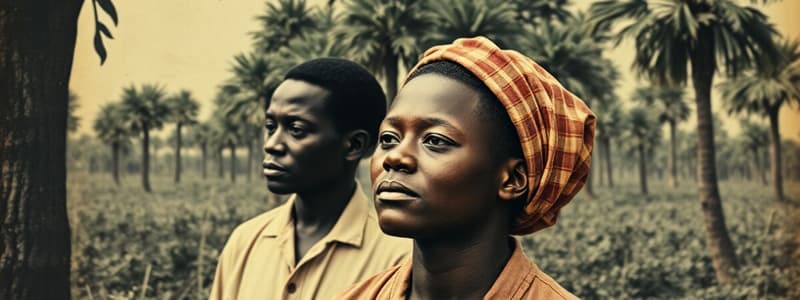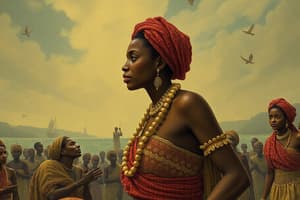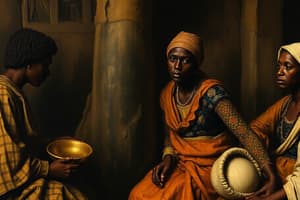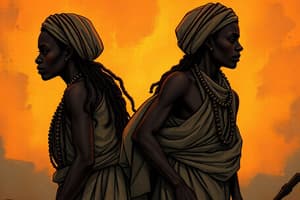Podcast
Questions and Answers
Before the Civil War, what was the most common relationship between white colonists and enslaved people in the Southern Colonies, and how did it shape daily life?
Before the Civil War, what was the most common relationship between white colonists and enslaved people in the Southern Colonies, and how did it shape daily life?
Most white colonists did not own enslaved people; small farmers often worked alongside those they enslaved, though they were not treated as equals.
What role did church services play for farm families in the Southern Colonies, considering the distances between farms?
What role did church services play for farm families in the Southern Colonies, considering the distances between farms?
Church services were major social events, providing opportunities for worship and socializing due to the long distances between farms.
Describe the daily life and working conditions of enslaved people on Southern plantations.
Describe the daily life and working conditions of enslaved people on Southern plantations.
Enslaved people on Southern plantations typically worked long hours in the fields, were subject to harsh treatment and abuse, and had limited to no personal freedoms. They were watched by an overseer.
Besides running away, how else did enslaved people resist their bondage?
Besides running away, how else did enslaved people resist their bondage?
In what ways did enslaved people actively resist the institution of slavery, despite the risks?
In what ways did enslaved people actively resist the institution of slavery, despite the risks?
What was the arrangement between the Seminole tribe and runaway enslaved people, sometimes known as Black Seminoles, regarding land and crops?
What was the arrangement between the Seminole tribe and runaway enslaved people, sometimes known as Black Seminoles, regarding land and crops?
How did the legal status of enslaved people evolve in the English colonies from the early 1600s to the mid-1700s?
How did the legal status of enslaved people evolve in the English colonies from the early 1600s to the mid-1700s?
Explain how enslaved people maintained and preserved their cultural identity despite the dehumanizing conditions of slavery.
Explain how enslaved people maintained and preserved their cultural identity despite the dehumanizing conditions of slavery.
How did Eliza Lucas Pinckney contribute to the economy of the South?
How did Eliza Lucas Pinckney contribute to the economy of the South?
Explain the significance of the term 'Black Seminoles' and how this group emerged.
Explain the significance of the term 'Black Seminoles' and how this group emerged.
What role did Christianity play in the lives of some enslaved people by the late 1700s?
What role did Christianity play in the lives of some enslaved people by the late 1700s?
What challenges did enslaved people face when attempting to escape, and what external factors influenced their success?
What challenges did enslaved people face when attempting to escape, and what external factors influenced their success?
How did plantation owners ensure the continuation of slavery through laws and practices?
How did plantation owners ensure the continuation of slavery through laws and practices?
How did the use of enslaved people change from the use of indentured servants?
How did the use of enslaved people change from the use of indentured servants?
In what ways did the daily life of enslaved people on small farms differ from those on large plantations, and what remained consistent?
In what ways did the daily life of enslaved people on small farms differ from those on large plantations, and what remained consistent?
Why did enslaved people sing songs and play drums and banjos?
Why did enslaved people sing songs and play drums and banjos?
Explain how Eliza Lucas Pinckney's work with indigo influenced the economy of South Carolina.
Explain how Eliza Lucas Pinckney's work with indigo influenced the economy of South Carolina.
How did the climate of the Southern Colonies influence the types of cash crops that were grown?
How did the climate of the Southern Colonies influence the types of cash crops that were grown?
What was the impact of growing tobacco on the land, and how did farmers adapt to this issue?
What was the impact of growing tobacco on the land, and how did farmers adapt to this issue?
Why were seaports crucial to the economy of the Southern Colonies, particularly concerning cash crops?
Why were seaports crucial to the economy of the Southern Colonies, particularly concerning cash crops?
Describe the transformation of rice into a major cash crop in South Carolina, including its nickname.
Describe the transformation of rice into a major cash crop in South Carolina, including its nickname.
What does Eliza Lucas Pinckney's quote, 'I hardly allow myself time to sleep or eat,' suggest about her dedication to her work?
What does Eliza Lucas Pinckney's quote, 'I hardly allow myself time to sleep or eat,' suggest about her dedication to her work?
How did the dependence on cash crops shape the economic and environmental practices of farmers in the Southern Colonies?
How did the dependence on cash crops shape the economic and environmental practices of farmers in the Southern Colonies?
Describe the relationship between cash crops, plantation economies, and the transatlantic trade network in the Southern Colonies.
Describe the relationship between cash crops, plantation economies, and the transatlantic trade network in the Southern Colonies.
Explain how the plantation system in the Southern Colonies contributed to both economic prosperity and social inequality.
Explain how the plantation system in the Southern Colonies contributed to both economic prosperity and social inequality.
Describe the difference in the daily life and living conditions between planters and enslaved people on a Southern plantation.
Describe the difference in the daily life and living conditions between planters and enslaved people on a Southern plantation.
Why was it illegal for enslaved people to learn how to read and write in the Southern Colonies?
Why was it illegal for enslaved people to learn how to read and write in the Southern Colonies?
In what ways did enslaved people resist or cope with their conditions on Southern plantations, according to the text?
In what ways did enslaved people resist or cope with their conditions on Southern plantations, according to the text?
How did the expansion of plantations from the Coastal Plain to farther inland impact the lives of enslaved people?
How did the expansion of plantations from the Coastal Plain to farther inland impact the lives of enslaved people?
What role did small farms play in the Southern Colonies' economy, despite the prominence of large plantations?
What role did small farms play in the Southern Colonies' economy, despite the prominence of large plantations?
How did some Africans manage to gain freedom, and what challenges did they face as free individuals in the Southern Colonies?
How did some Africans manage to gain freedom, and what challenges did they face as free individuals in the Southern Colonies?
What was the relationship of the overseer's house and the enslaved workers' houses?
What was the relationship of the overseer's house and the enslaved workers' houses?
Flashcards
Cash Crops
Cash Crops
Crops grown for profit, like tobacco, rice, and indigo.
Tobacco
Tobacco
Major cash crop in Maryland, Virginia and northern North Carolina. Required many workers and a lot of land.
Charles Town
Charles Town
Seaports crucial for exporting cash crops.
Rice
Rice
Signup and view all the flashcards
Indigo Dye
Indigo Dye
Signup and view all the flashcards
Eliza Lucas Pinckney
Eliza Lucas Pinckney
Signup and view all the flashcards
Location's Effect on Crops
Location's Effect on Crops
Signup and view all the flashcards
Indigo's Growth
Indigo's Growth
Signup and view all the flashcards
Southern Colonies Economy
Southern Colonies Economy
Signup and view all the flashcards
Escaping Slavery
Escaping Slavery
Signup and view all the flashcards
Treatment of Enslaved People
Treatment of Enslaved People
Signup and view all the flashcards
Church Social Events
Church Social Events
Signup and view all the flashcards
Seminole Aid
Seminole Aid
Signup and view all the flashcards
Land Sharing
Land Sharing
Signup and view all the flashcards
Black Seminoles
Black Seminoles
Signup and view all the flashcards
Plantation Economy
Plantation Economy
Signup and view all the flashcards
Planters
Planters
Signup and view all the flashcards
Plantation System
Plantation System
Signup and view all the flashcards
Enslaved People
Enslaved People
Signup and view all the flashcards
Overseer
Overseer
Signup and view all the flashcards
Plantation Workshops
Plantation Workshops
Signup and view all the flashcards
Small farms
Small farms
Signup and view all the flashcards
The Atlantic Slave Trade
The Atlantic Slave Trade
Signup and view all the flashcards
Hereditary Enslavement
Hereditary Enslavement
Signup and view all the flashcards
Forms of Resistance
Forms of Resistance
Signup and view all the flashcards
Preserving Culture
Preserving Culture
Signup and view all the flashcards
Legality of Slavery
Legality of Slavery
Signup and view all the flashcards
Study Notes
- Traders brought millions of Africans to North America, South America, and the Caribbean for over 300 years.
- These Africans were taken from their homes, chained on ships, and sold into slavery.
Treatment of Enslaved People
- The first Africans likely arrived in the English colonies in Virginia in 1619.
- Initially, English colonies used indentured servants as workers.
- As more workers became necessary, colonial governments legalized slavery.
- By the mid-1700s, slavery was legal in every colony.
- Laws stated that children born to enslaved people were also enslaved.
- Families were often separated and sold to different owners.
- Most enslaved Africans in the Southern Colonies worked on plantations.
- Treatment varied depending on the owner and they were often beaten and abused.
- Escape was difficult, but enslaved people still attempted to resist slavery.
- Resistance included rebellion, breaking tools, feigning illness, or working slowly.
- Harsh punishments were common for such acts.
- Enslaved people preserved their culture through storytelling and songs about Africa.
- By the late 1700s, Christianity became a source of strength for some enslaved people.
- Enslaved people preserved culture with music, playing drums and banjos.
A Farming Economy
- The Southern Colonies' economy was based on plantations, which relied on the labor of enslaved people.
- Cash crops produced by enslaved workers made plantation owners, or planters, wealthy.
- Plantations resembled small villages with workshops where enslaved people made nails, bricks, barrels, and other items.
- Plantation owners hired an overseer to supervise enslaved workers.
- The overseer lived near the fields, while enslaved workers' houses were far from the planter's house.
- Some enslaved people maintained small gardens near their homes.
- Planters managed plantations but did not typically perform manual labor.
- They sometimes served the community as judges or assembly members.
- Planters hired teachers to educate their children at home.
- Enslaved children were prohibited from attending school and learning to read or write, with punishment for those caught trying.
Life on Small Farms
- While the Southern Colonies' economy depended on crops from large plantations, most colonists lived and worked on small farms.
- Former indentured servants sometimes owned these small farms, though few became rich.
- Most small farm owners did not own enslaved people.
- Those who did work alongside enslaved labourers but did not treat them as equals.
- Church services were important events due to the distance between farms, involving travel, attendance, and socializing.
Free Africans
- Some Africans were able to buy their freedom and start farms.
- Most did not want to be part of the system of slavery.
- Some free Africans bought relatives to liberate them.
- Many enslaved people ran away to escape slavery, but were often caught and returned.
- Some found refuge in Spanish Florida or with Native American tribes.
The Black Seminoles
- The Seminole tribe provided runaway enslaved people with food and shelter.
- The Seminole gave land to runaways who gave back one-third of the crops they grew.
- Many runaways dressed like the Seminole, learned their language, and became known as Black Seminoles.
Eliza Lucas Pinckney
- Eliza Lucas Pinckney moved to South Carolina with her parents in 1738.
- She experimented with indigo seeds and grew an indigo plant that produced excellent dye.
- She shared seeds with neighbors and friends.
- South Carolina planters were selling one million pounds of indigo a year to European clothmakers within a few years.
Cash Crops
- Seaports like Charles Town were important to the economy of the Southern Colonies.
- Plantations produced large quantities of cash crops for markets in England and the West Indies.
- Different colonies grew different crops based on climate.
- Maryland, Virginia, and northern North Carolina: tobacco was the main cash crop.
- Tobacco cultivation requires labor and land and depletes soil nutrients.
- Southern North Carolina, South Carolina, and Georgia: rice became a major cash crop known as "Carolina gold".
- Indigo plants, producing a blue dye, grew well on drier land.
- Eliza Lucas Pinckney's experiments led to indigo becoming a major cash crop in South Carolina by the 1740s.
The Economy Grows
- Plantations were largely self-sufficient but depended on merchants for some goods and services.
- Traders and merchants relied on plantations for cash crops and raw materials, this is Interdependence.
Exporting Goods
- As plantations expanded, so did the export of cash crops.
- Large plantation owners typically used a broker to sell their crops.
- Brokers are paid to buy and sell for others, taking crops to market and buying goods for planters.
- Location was a factor in the success of plantations. The most successful were near rivers or ports for easy shipping.
- Location also influenced the growth of cities.
- By the mid-1700s, cities like Norfolk and Savannah grew along the southern Atlantic coast.
- Baltimore, Maryland, was founded in 1729 on the Patapsco River.
- Baltimore exported grain and tobacco.
- As exports increased, Baltimore became a major shipbuilding center, developing the Baltimore clipper ship.
Other Industries
- Farming was most important segment within the economy.
- Forests in the region provided resources.
- Forests aided Wilmington, North Carolina.
Studying That Suits You
Use AI to generate personalized quizzes and flashcards to suit your learning preferences.




